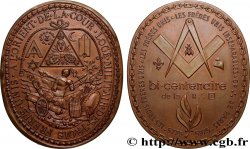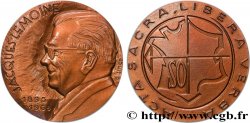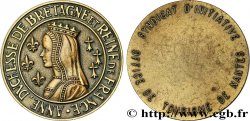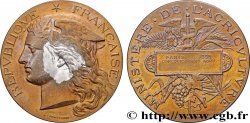fme_1053450 - FUNFTE FRANZOSISCHE REPUBLIK Médaille, Bicentenaire de la Révolution, L’être suprême
40.00 €
Menge
In den Warenkorb

Type : Médaille, Bicentenaire de la Révolution, L’être suprême
Datum: 1987
Name der Münzstätte / Stadt : Monnaie de Paris
Metall : Bronze
Durchmesser : 77 mm
Stempelstellung : 12 h.
Graveur MAUVIEL Jacki (1935-)
Gewicht : 248,08 g.
Rand lisse + corne BR + 1987
Punze : corne BR
Kommentare zum Erhaltungszustand:
Patine hétérogène. Présence d’un minime coup sur la tranche. L’avers présente de légers points d’oxydation
Vorderseite
Titulatur der Vorderseite L’ÊTRE SUPRÊME.
Beschreibung Vorderseite Foule au pied d’une coline sur laquelle se trouve un arbre entre le soleil et un oeil omniscient .
Rückseite
Titulatur der Rückseite BICENTENAIRE / DE LA / RÉVOLUTION / FRANÇAISE.
Beschreibung Rückseite Légende en 4 lignes horizontales.
Kommentare
Médaille conservée dans un écrin en carton bordeaux de la monnaie de Paris.
Le culte de la Raison des Hébertistes athées (automne 1793 – printemps 1794) puis le culte de l'Être suprême des Montagnards déistes (printemps – été 1794) sont, en France, un ensemble d'événements et de fêtes civiques et religieuses. Le théophilanthropisme est une émanation du culte de l'Être suprême apparu en 1796 (26 nivôse an V) et interdit en 1803.
Il est explicitement fait référence à l'Être suprême dans le préambule de la Déclaration des droits de l'homme et du citoyen de 1789, qui est un pilier du système juridique, politique et social français :
« L'Assemblée Nationale reconnaît et déclare, en présence et sous les auspices de l'Être suprême, les droits suivants de l'Homme et du Citoyen ».
Medal preserved in a burgundy cardboard case from the Paris Mint. The cult of Reason of the atheist Hébertists (autumn 1793 – spring 1794) and then the cult of the Supreme Being of the deist Montagnards (spring – summer 1794) are, in France, a set of civic and religious events and festivals. Theophilanthropism is an emanation of the cult of the Supreme Being which appeared in 1796 (26 Nivôse Year V) and was banned in 1803. Explicit reference is made to the Supreme Being in the preamble to the Declaration of the Rights of Man and of the Citizen of 1789, which is a pillar of the French legal, political and social system: \\\"The National Assembly recognizes and declares, in the presence and under the auspices of the Supreme Being, the following rights of Man and of the Citizen\\\"
Le culte de la Raison des Hébertistes athées (automne 1793 – printemps 1794) puis le culte de l'Être suprême des Montagnards déistes (printemps – été 1794) sont, en France, un ensemble d'événements et de fêtes civiques et religieuses. Le théophilanthropisme est une émanation du culte de l'Être suprême apparu en 1796 (26 nivôse an V) et interdit en 1803.
Il est explicitement fait référence à l'Être suprême dans le préambule de la Déclaration des droits de l'homme et du citoyen de 1789, qui est un pilier du système juridique, politique et social français :
« L'Assemblée Nationale reconnaît et déclare, en présence et sous les auspices de l'Être suprême, les droits suivants de l'Homme et du Citoyen ».
Medal preserved in a burgundy cardboard case from the Paris Mint. The cult of Reason of the atheist Hébertists (autumn 1793 – spring 1794) and then the cult of the Supreme Being of the deist Montagnards (spring – summer 1794) are, in France, a set of civic and religious events and festivals. Theophilanthropism is an emanation of the cult of the Supreme Being which appeared in 1796 (26 Nivôse Year V) and was banned in 1803. Explicit reference is made to the Supreme Being in the preamble to the Declaration of the Rights of Man and of the Citizen of 1789, which is a pillar of the French legal, political and social system: \\\"The National Assembly recognizes and declares, in the presence and under the auspices of the Supreme Being, the following rights of Man and of the Citizen\\\"








 Berichten über einen Fehler
Berichten über einen Fehler Die Seite drucken
Die Seite drucken Teilen meiner Auswahl
Teilen meiner Auswahl Stellen Sie eine Frage
Stellen Sie eine Frage Einlieferung/Verkauf
Einlieferung/Verkauf
 Details
Details












